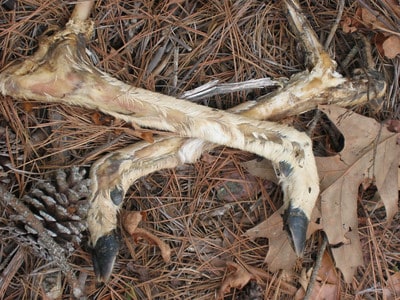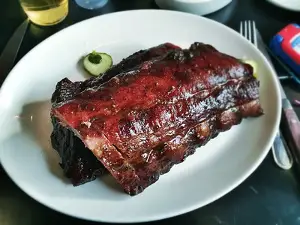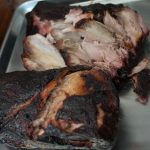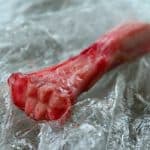
Whether you’re just looking for a new snack to try out for your dog or you enjoy hunting and want to share some of your spoils with your furry friend, giving your dog a deer leg seems like a good idea.
And as we all know, dogs love bones.
So are deer legs safe for dogs, and are they nutritious enough to be worth it?
I have all the answers for you here, so let’s find out if deer legs are a good snack for your dog.
And also take a look at some tips to make sure it’s right for your dog specifically.
What nutrition do dried deer legs offer dogs?
You might not think that deer legs are all that nutritious considering it’s mostly bone, but you would be wrong.
Dried deer legs actually have several beneficial nutrients for dogs including protein, fat, calcium, iron, and manganese.
And in addition to these nutrients, your dog will also ingest collagen from the cartilage inside the bones as well as the soft tissue attached to the outside of the bone.
Collagen is great for dogs and boosts bone, joint, and even coat health.
It’s important to note that your dog shouldn’t be “eating” the entire bone anyway, just the cartilage. Dogs cannot digest bones.
What other benefits do chewing on deer legs offer dogs?
And the benefits of deer legs don’t stop with nutrition.
Although you should only give your dog deer legs for a maximum of thirty minutes at a time, the deer legs will last for hours if you add up all of the sittings.
And I will look into how used dog bones can be stored in a later section.
This means that it will provide your dog with hours of entertainment, and help combat boredom. And if there’s one thing that all dog owners know, it is that a bored dog makes for a tough day.
While your dog is chewing on deer legs, it’s actually improving its dental health as well.
Not only does the texture of deer bones help remove plaque and tartar build up on your dog’s teeth, but it also helps strengthen their teeth as well as their jaw.
Additionally, deer legs make for great snacks for dogs on a low fat diet.
And before I look at some of the possible drawbacks of giving your dog deer legs, I want to look at an issue that I touched on a short while ago- used dog bone storage.
How can I store partly chewed dog bones?
There are two reasons for storing used dog bones and one reason not to.
You should store dog bones firstly because, in an ideal world, a dog should never be allowed to finish a bone in one sitting.
Secondly, most of us buy the bones that we give to our dogs and so it is a waste of money to throw away a partly gnawed bone.
On the flip side, a very good reason that you shouldn’t store used bones is because they are disgusting.
Not only are you dealing with raw meat but you will also be dealing with lots of dog slobber.
And who wants to put that in their fridge or freezer?!
Nobody in their right mind is who…
Old bones can be stored in a fridge for a few days or even in a freezer for a few weeks.
In order to be as safe and hygienic as possible then you really need a separate fridge or freezer- one that is just used for your dogs and has nothing in it that will be consumed by humans.
Even then, you will want to place the bone in a plastic bag in order to keep the dribble and bacteria contained.
And if you freeze them, let the bone defrost before giving it to your dog.
Frozen bones will at the very least break your dog’s teeth…
What are the potential dangers of dried deer legs?
The main risks when a dog eats deer legs is choking and intestinal blockages.
Choking can occur when the bones splinter or your dog breaks too big of a piece off.
And intestinal blockages can happen when your dog eats too big pieces, or too much bone at once.
This is why it’s important to keep an eye on your dog and keep the sessions with the deer leg somewhat limited.
Furthermore, you shouldn’t give deer legs to your dog if your dog has a tendency of eating treats quickly.
Only give your dog deer legs if your dog typically gently gnaws on treats and only bites small parts off.
Can I give my dog a deer bone I found in the woods?
Despite the fact that deer bones can be safe for dogs to eat, you still shouldn’t give your dog a deer bone that you find in the woods.
This option can be tempting because it’s free, and looks like a nice treat for your pup but it isn’t safe.
The reason for this has to do with age.
You have no idea how long the bone has been laying there, there could be loads of bacteria on it. And aside from that, the older bones get the brittle they become.
Brittle bones are dangerous for dogs since they can not only break or damage their teeth, but also present a choking hazard.
How expensive are deer legs?
The prices of deer legs are going to vary somewhat depending on where you source them, the quality, and the size.
But I can share some general pricing with you here.
Deer legs tend to sell for about $5 – $10 per leg.
You can typically find them in packs ranging from packs of two to packs of twelve and beyond, so you could buy them in bulk if you wanted to and if your dog seems to enjoy them.
Where can I buy deer legs?
There are a lot of places you can buy deer legs, and maybe you could even find somewhere locally to buy some.
As far as online shopping goes, there are a lot of third party/privately owned shops where you can buy them.
Or you could go with some of the larger shopping sites such as Amazon, Etsy, or Ebay where they are available as well.
What other parts of a deer can a dog eat?
Your dog can safely consume most parts of a deer if it is processed correctly.
They can definitely eat the venison (deer meat) as long as you freeze it in order to kill the bacteria that can sometimes be present.
And in fact, venison is quite good for your dog.
Venison can even be given to your dog raw, if you’re trying a raw diet.
Your dog would probably also enjoy chewing on the antlers of a deer, and it is safe for them to do so.
Dogs can also eat the heart, lungs, liver, and the ribs/breastplate.
You should never feed your dog the brain, eyes, spinal cord, lymph nodes, tonsils, or the spleen since these things can be infected with Chronic Wasting Disease (CWD).
What other dried animal feet might your dog enjoy?
Chicken feet is a great snack for your dog despite the fact that chicken bones can be dangerous.
Chicken bones function like all animal bones in the way that if they are cooked, boiled, or fried they become hard like glass and could kill your dog if ingested.
So as long as the chicken feet are air-dried they should be safe for canine consumption. And they’re packed with nutrition.
Raw pig’s feet might also be a good option for a healthy snack.
These will keep your dog entertained for hours and provide some nutrition.
Additionally, most hooves are hollow so you could probably sneak another healthy snack, such as peanut butter, into them for even more nutrition.
But just like with the deer legs, make sure to only give your dog this treat if they aren’t an aggressive chewer.
Aggressive chewers could splinter the hooves and swallow some which could be dangerous, or at the very least they could crack a tooth trying.
What types of dog are best suited to chewing deer legs?
Pretty much any breed of dog can chew on deer legs, aside from very small breeds like toy dogs.
A medium to large sized breed should be able to chew on deer legs safely, unless they’re aggressive chewers like mentioned above.
The perfect type of dog for chewing on deer legs would be a dog that gently gnaws on their treats, the bone will last longer this way and it won’t present a choking hazard.
Should puppies be given dried deer legs?
Puppies should not be given dried deer legs, both because of their size and the fact that they’re generally impatient. But as long as they don’t fit into the categories mentioned above then they should be able to chew on deer legs once they reach adult size.
Can I store deer legs?
You can store deer legs, or any part of the deer that you’re going to feed your dog, in the freezer.
By freezing the parts you should be getting rid of any potential bacteria that may be present. If you do freeze some organs to feed your dog then you should only give it to them in small portions about once a week.
Organ meat do contain a lot of nutrition but can cause things like diarrhea and gas if you feed your dog too much at once.
In conclusion…
Deer legs can be safely consumed by dogs as long as they aren’t cooked; unless the dog is an aggressive chewer, a puppy, or a toy breed.
Deer legs, and other parts of a deer, can be really beneficial to dogs and contain a lot of nutrition.
Furthermore, deer legs can keep your dog entertained for a while and clean their teeth in the meantime.
All in all, deer legs make a great treat for our furry friends as long as the sessions with it are controlled and monitored.
And other parts that deer have to offer can be a great addition to a raw diet.





